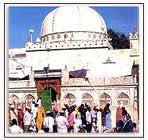Urs Festival2012
The Urs of Moinuddin Chishti started in 1212 A.D. It is celebrated every year in the first week of Islamic month of Rajab, on seeing the moon of Rajab, the seventh month of the Islamic calendar. Drums are beaten to herald the commencement of the annual ceremony.The word Urs is derived from “uroos”, which means “ultimate meeting of an individual with God”. It is said that Moinuddin Chishti spent the last six days of his life in seclusion in a Huzra (room meant for prayers), and on the sixth day of Rajab he died.
Urs Festival of Ajmer Sharif is held in the holy town of Ajmer in Rajasthan , India . The Urs Festival in Ajmer , Rajasthan is marked with quwwallis – sung at night. The celebrations the unite people of all faiths, and the complete town is decorated with buntings and wears the spirit of festivity.
The six-day Urs festival recreates the memory of those six days during which Khwaja Hasan Chisti retired to his personal quarters for prayer and meditation till he breathed his last. The Urs festival celebrations are inaugurated by Sajjada Nashin, a descendant of the Chisti family.
The Sajjada Nashin hoists a pure white flag atop the Dargah dome followed by the ghusal ritual during which the grave of the great saint is washed with rose water and anointed with sandalwood paste, ghee and incense. Pilgrims come from far and wide to pay homage to their beloved saint and seek his blessings.
.jpg) Special poetry recitation sessions are conducted in the Mehfil Khana located within the Dargah premises. Pilgrims carry chadars, roses, jasmines, gilaph and neema offerings on their heads to the door of the main Dargah where these are handed over to khadims who offer these to the saint’s tomb. An important ritual that marks the Urs festival celebrations is the cooking of the sacred kheer or milk pudding that is later distributed to the devotees who throng the grave.
Special poetry recitation sessions are conducted in the Mehfil Khana located within the Dargah premises. Pilgrims carry chadars, roses, jasmines, gilaph and neema offerings on their heads to the door of the main Dargah where these are handed over to khadims who offer these to the saint’s tomb. An important ritual that marks the Urs festival celebrations is the cooking of the sacred kheer or milk pudding that is later distributed to the devotees who throng the grave. Hazrat Khwaja Moinuddin Hasan Chisti was a Persian fakir who began the Chistia fakir sect in India and is considered as the messenger of Allah by the Muslims.
.jpg)
.jpg)


.jpg)


.jpg)
